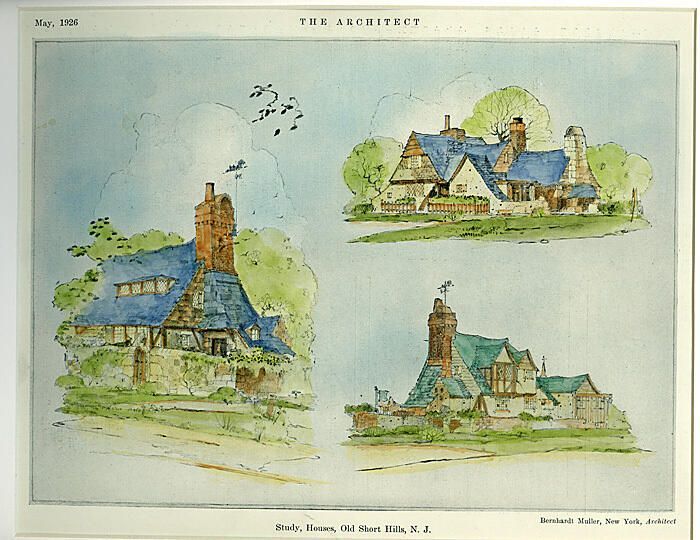Archive Entry
One Nottingham (Robin Hood Cottage), Bernhardt Mueller architect, 1926
Print
A hand-colored, printed sketch of Robin Hood Cottage at One Nottingham in Short Hills from the periodical, "The Architect," December 1926. Home of Mr. Kirk McFarlin. Printed on top edge of print is "May, 1926; The Architect" Printed on the bottom edge is: "Study, Houses, Old Short Hills, N.J.; Bernhardt Muller, New York, Architect" What shows of the print through the mat is a hand-colored, printed sketch of the house at 1 Nottingham.
Bernhardt Emil Muller (1878-1964) was born in Fremont, Nebraska on December 27, 1878. He studied at L’Ecole Des Beaux Arts in Paris from 1903 to 1905, then traveled and studied for a year in Italy, France, Austria, and Germany. He began his career as a draftsman for the New York architectural firm of Trowbridge and Livingston in 1906. In 1909 he became a designer for the firm of Robert J. Reiley. Mulller moved on to the firm of D. Everett Waid in 1912 where he was also employed as an architectural designer until 1914, when he opened his own office in New York City.
A member of the First Church of Christ, Scientist, in Maplewood, New Jersey, Bernhardt Muller designed a number of Christian Science churches, located mostly in the state of New York. The American Architect Directory of 1956 lists his most notable designs for these churches as those in Brooklyn (1918), Hempstead (1924), Forest Hills (1925), Bronxville (1929), and Flushing (1930), all in New York, as well a building for a new congregation in Opa-Locka (1930). Muller was noted for his design of small suburban houses in Short Hills, Maplewood, and Millburn, New Jersey, mostly of the Tudor English motif, which was characteristic of his own home in Millburn.
Muller was elected to membership in the American Institute of Architects (A.I.A.) in 1924; he was a member of the New York City chapter. Muller attained the status of Emeritus member of the A.I.A. in 1952. He was also a member of the Summit (New Jersey) Art Association.
Muller is best known for his work in the Moorish revival style in South Florida, especially those in the city of Opa-locka.
2010.043.001
2010.043
10-1/2 in
8-1/4 in
